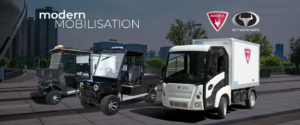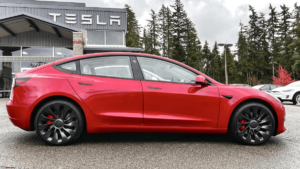
[ad_1]
The government recently announced plans to boost the roll-out of autonomous vehicles on UK roads by 2025. Will it spark a transport revolution to improve road safety and better connect communities?
As the Boris Johnson administration drew to a close, one government department that didn’t get the memo to down tools was the Department for Transport. In August, the DfT announced a £100m funding boost for what it called a “self-driving revolution”, setting Britain on a course towards a future where autonomous cars, coaches and lorries could be running on our roads from as early as 2025.
It’s simultaneously a bold new step and utterly uncontroversial, as whoever is living in Downing Street is going to have to deal with the reality that autonomous vehicles (AVs) are coming.
However, what’s important about AVs is not just what Tesla, Google, and maybe even Apple are up to. What’s going to be just as critical is the road network on which the ‘revolution’ takes place. So just how are AVs going to change our roads?
“That’s the fundamental question that keeps me up at night,” laughs Andy Fisher, the Connected and Autonomous Vehicles team leader at National Highways, the government agency that sets road standards and manages England’s strategic road network.
“There is no set standard for how these vehicles are going to emerge, or the technology that will be used to drive them,” says Fisher, “so they’re all going to be using different types of technology and different types of sensors to build the picture for the vehicle. Some will require onboard cameras, some will not. Some will adopt a data-feed approach. So we’re going to have to come up with a whole suite of ideas, and a whole suite of answers to fit everyone and every vehicle’s capability. And that’s the trouble we’re facing, because there’s going to be no one-size-fits-all model.”
Perhaps the obvious place to start is what is already on the road. Though AVs are still some distance from achieving the much-desired dream of ‘level 5’ full autonomy, there are already millions of cars equipped with sensors that can, for example, match speed with the car ahead, or use the white lines on the road to steer automatically. Does this therefore point to a future where roads will have to be maintained to a much higher standard to keep the white lines and street furniture in good condition?
“We have colleagues that are concerned quite rightly that maybe white lining could be an issue, so we [may] have to increase levels of funding and resources to maintain white lining more effectively,” says Fisher. “But then we hear from vehicle manufacturers saying ‘no, it’s probably not too bad’.”
“If you look at the experience of [Google’s] Waymo and Tesla, they’re much happier working on highways with a central reservation in the middle, with nice clear lane markings, and so on and so forth, than they are working on a country lane,” says Michael Dnes, head of future roads technology at the DfT and chair of the International Transport Forum’s study into autonomous mobility. “But this doesn’t mean the answer is necessarily more central reservations, more lane markings and a more carefully ordered approach to how roads are designed and maintained.
“You probably don’t want to rebuild all your roads as heavy-built highways, because the technology would probably [improve] far faster than any building could be.”
‘You can’t talk about building an AV-perfect road. There are some things that are helpful. No potholes, good markings, good signs, they all are useful. But this doesn’t add up to a construction standard.’
Instead, Dnes argues that it could be more important to focus on what he calls “invisible infrastructure”, such as ensuring that roads have good 5G mobile reception, and that digital models of the road network are detailed and up-to-date.
“The physical world itself isn’t the highest priority,” says Dnes. “You can’t talk about building an AV-perfect road. There are some things that are helpful. No potholes, good markings, good signs, they all are useful. But this doesn’t add up to a construction standard.”
The big challenge, then, for transport agencies in the future could be mapping and data, rather than construction.
“We’re focusing on improving the data that we publish and make available,” says Fisher. “That’s mostly for humans, but in the longer term, there’s no reason why that same data couldn’t go straight into a self-driving vehicle and it could use that information as part of its decision-making processes.”
Dnes points to South Korea and Japan as exemplars of this mapping-focused approach to preparing the roads for autonomy. “They have been out mapping Korea’s roads for about four years now. It’s part of their basic design standard. They’ve done the equivalent of all their motorways and major A-roads. And Japan is now in the process of doing much the same thing as well.”
What’s striking about the idea of governments building detailed digital maps or ‘digital twins’ of their real road networks is the cost, or lack thereof.
“It costs a lot less than you think it might do, certainly compared to the classic heavy highways work,” says Dnes. “If you want to lay a couple of miles of tarmac, prepare to hand over a couple of hundred million pounds. We’re talking single-digit millions for most of the [digital] work. So, it’s not as expensive as it first looks.”
There is, however, an obvious next step to autonomy: getting vehicles to talk to each other, and embedding sensors into road infrastructure, to extend each vehicle’s eyes and ears beyond their immediate surroundings.
Mahmood Hikmet, head of research and development at autonomous vehicle firm Ohmio, argues that there is something of a chicken-and-egg situation, with car manufacturers needing the infrastructure, and governments needing the cars to justify the infrastructure. A few years ago, this led to a change in attitude.
“What autonomous vehicle companies started to do is they said, ‘well, we can’t rely on infrastructure whatsoever’, so everything needs to be on the vehicle,” says Hikmet. “So you saw this big centralisation of sensors with these autonomous vehicles.”
He describes how the manufacturers essentially changed their approach to one where the vehicle treats the road and everything outside itself as a hostile environment and has to rely on its own sensors to build up a picture of the outside world.
However, the pendulum may now be swinging back the other way, with the prospect of sensors in infrastructure once again being taken more seriously by the car industry.
“If you’ve got a blind corner that you need to see around, what a vehicle needs to do today, if it’s an autonomous vehicle, is peek its nose out from behind, and maybe like, overstep the mark, and go into the intersection a little bit,” says Hikmet. “That’s not necessarily a good thing, because the vehicle is putting itself in danger.
“So how do you solve this problem? By putting, say, a lidar sensor or other form of sensor across the road that’s able to see up and down the road, and connecting to that.”
And for manufacturers, this means taking a hybrid approach, building vehicles that can connect to sensors in the road – while also maintaining the car’s own array of sensors as the backbone of the vehicle.
However, even if embedding sensors is the plan, and even if vehicle communication standards can be agreed, it might not be so easy. John Paddington, an intelligent transport consultant with a local authority background, points to the difference between, for example, Innovate UK’s Transport Vision 2050 autonomous transport plan and the real world.
“One of the things it says is that effectively, every junction practically becomes a smart junction, so that kind of helps implement these ideas,” says Paddington. “But if you look at the reality on the ground, most local authorities, particularly in their roads departments, are really struggling with funding, just to maintain what they’ve got. I think there’s this question of how we bring in the new stuff without the funding.”
In any case, the transition to autonomy is arguably already under way, and if Tesla CEO Elon Musk is to be believed, the first fully autonomous cars could already be on the road – we just need to wait for the software updates.
If we do reach a future where vehicles are talking to vehicles, and all traffic is autonomous, it could fundamentally reshape the challenge of managing Britain’s roads.
“We’re in this position where, as a road network operator, we love control. We like to control and manage the traffic on our roads. [But] it would be easier all around, although I suspect it would not sit comfortably with road operators, if vehicles could manage themselves. If vehicles could talk to vehicles and it would leave us out of the equation, we’d feel very bad about that. Half our business would kind of disappear because we’d just become tarmac providers,” says Fisher at National Highways.
“That makes a lot of people uncomfortable, but it is something that we need to consider.”
Sign up to the E&T News e-mail to get great stories like this delivered to your inbox every day.
[ad_2]
Source link


